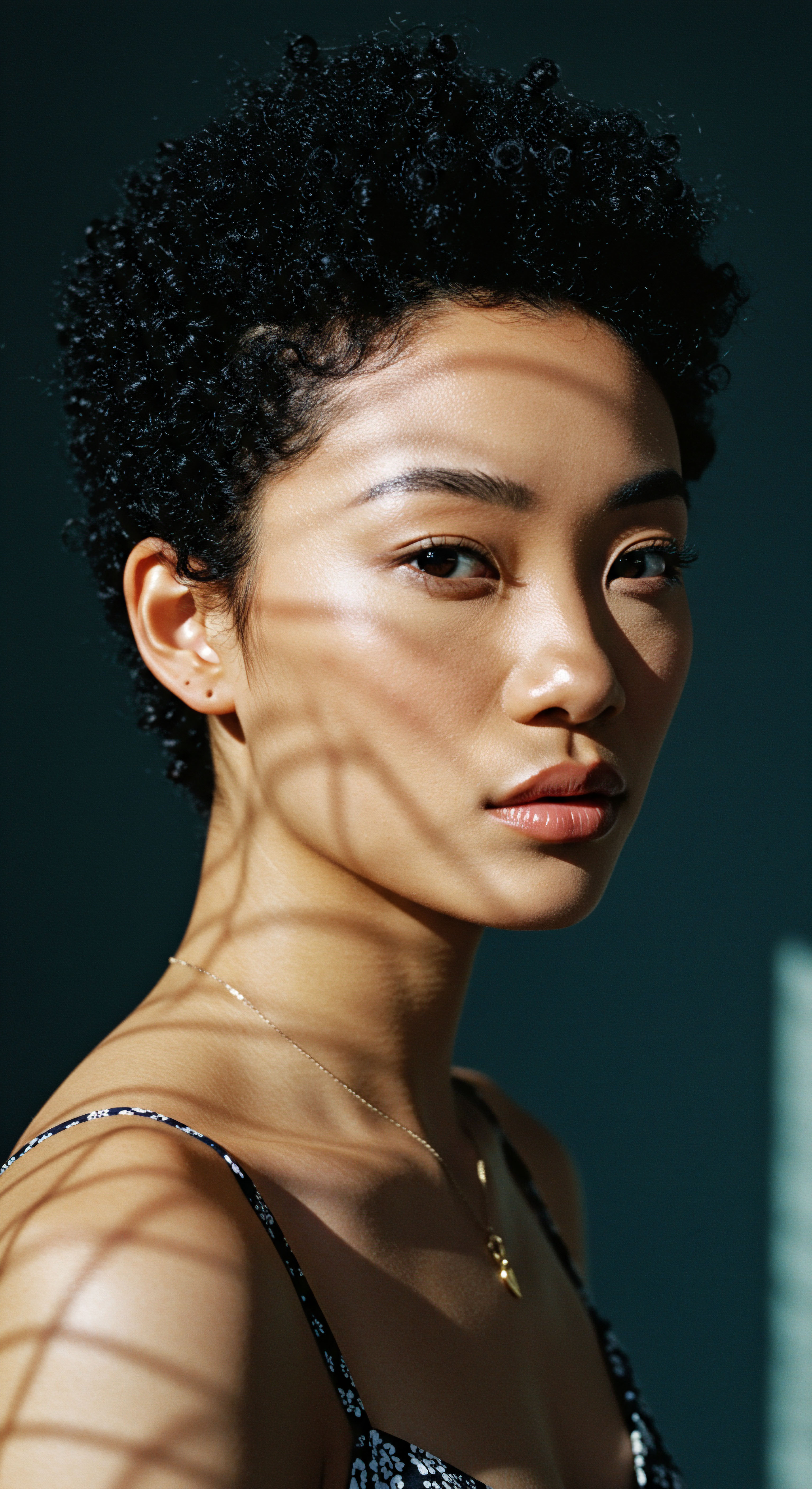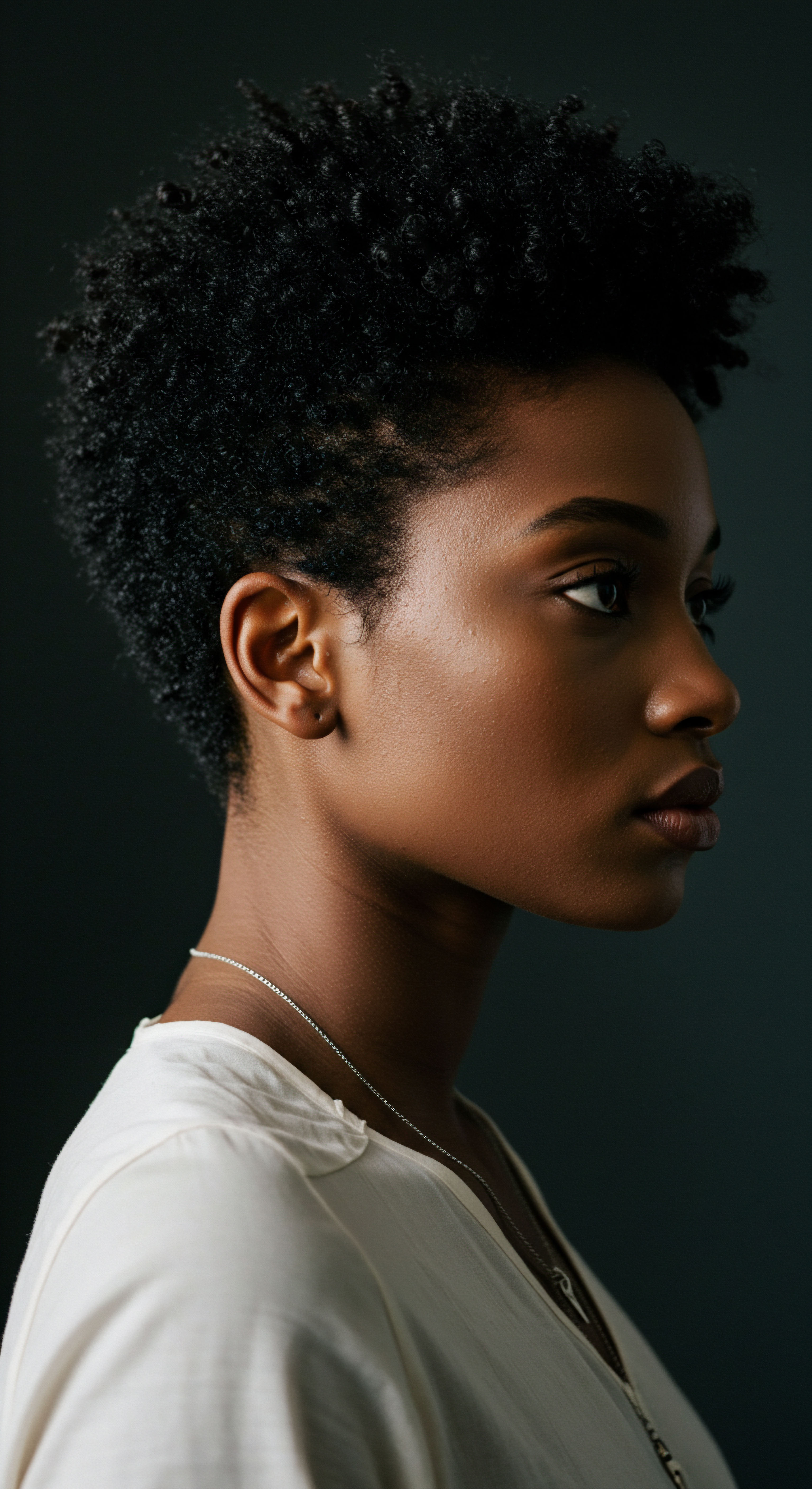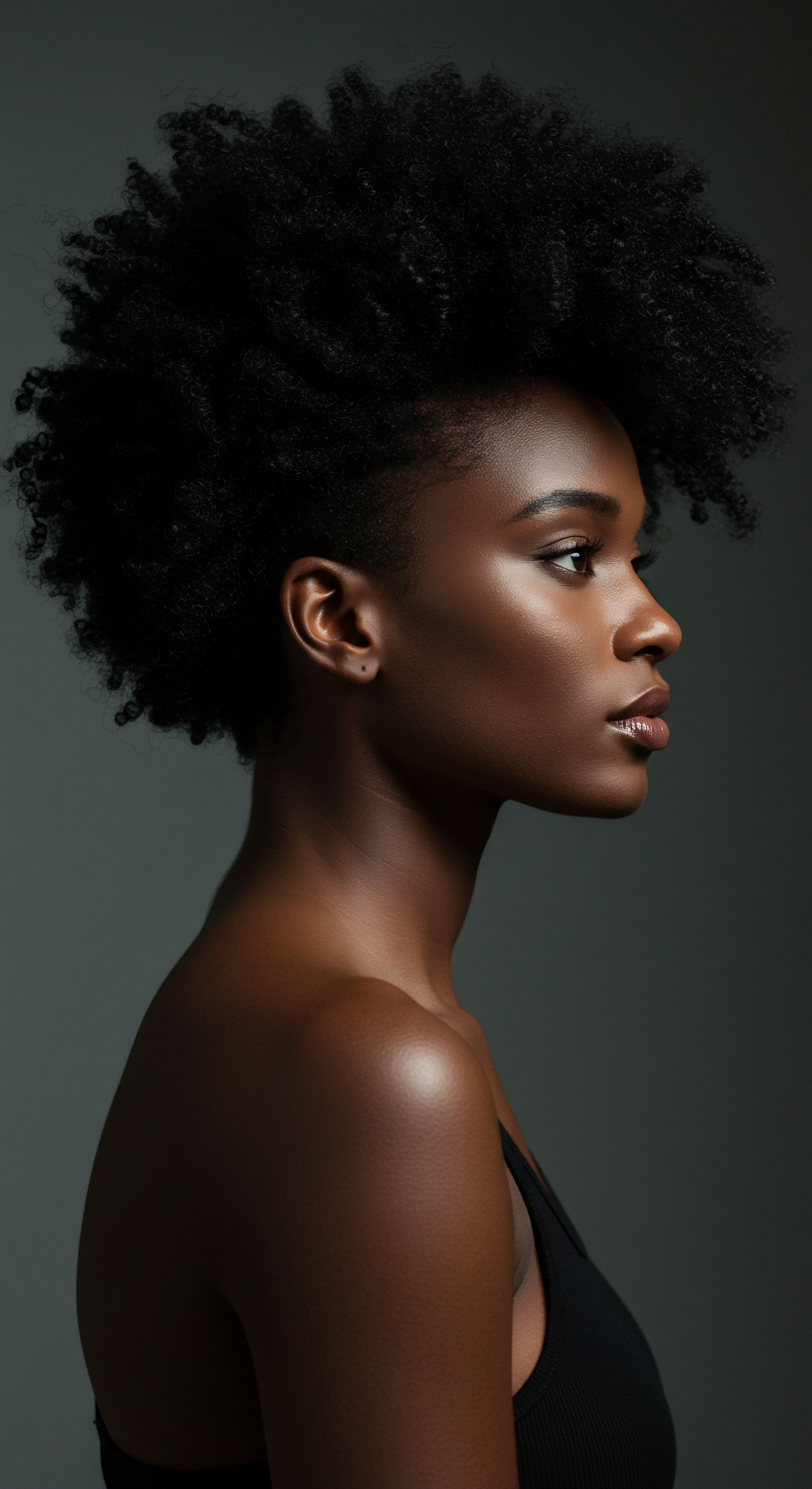
Roots
Beneath the visible cascade of curls, coils, and waves, a silent conversation unfolds. It is a dialogue between the rhythms of our bodies and the very life of our hair. Often, we gaze upon our textured strands, observing their behavior, their response to moisture, or their inclination to shrink, yet rarely do we pause to consider the invisible forces at play.
Among these forces, the delicate balance of hormones, shaped profoundly by the quality of our sleep, holds a surprising sway over the vitality of our hair. This understanding begins not with superficial remedies, but with a respectful inquiry into the biological rhythms that govern our entire being, including the hair that graces our crowns.
Hair, in its magnificent diversity, is more than just protein; it is a living extension of our inner landscape, responsive to the subtle shifts within. For textured hair, with its unique structure and inherent needs, these internal signals are particularly pertinent. A truly vibrant head of hair, one that retains its moisture, exhibits strength, and possesses a joyful spring, reflects an inner state of balance. When sleep, the great restorer, falters, so too do the hormonal messengers that guide our hair’s cyclical existence.

The Hair Cycle’s Internal Clock
Each individual hair follicle operates on a meticulous schedule, cycling through phases of growth, transition, and rest. This cyclical process is deeply tied to our body’s overarching biological rhythms. The active growth phase, known as anagen, can last for years, while the catagen phase is a brief period of regression. Following this, the telogen phase is a resting period before the hair sheds and the cycle begins anew.
Approximately 85-90% of scalp hair resides in the anagen phase at any given moment. Disruptions to this delicate timing can lead to accelerated shedding or slowed growth.
The intricate dance of hair growth follows a precise biological clock, profoundly influenced by our body’s internal rhythms.
The hair follicle itself possesses an internal clock, governed by specific clock genes. These genes orchestrate the daily fluctuations in cell activity within the follicle, dictating when stem cells are most receptive to growth signals and when they are primed for rest. This local rhythm within the hair follicle is a testament to the sophisticated self-regulation present even at the microscopic level of our biology.

What Role Do Circadian Rhythms Have in Hair Follicle Activity?
The circadian rhythm, our body’s natural 24-hour cycle, synchronizes nearly every physiological process, from our sleep-wake patterns to hormone secretion and cellular regeneration. This rhythm is not merely about when we sleep; it is a fundamental orchestrator of cellular behavior, including the intricate activities within our hair follicles. The skin, a prominent organ, possesses its own peripheral circadian clock, which influences various functions, including stem cell activity and tissue regeneration.
When this fundamental rhythm is disturbed, such as through inconsistent sleep schedules or exposure to artificial light at night, the consequences extend beyond feeling tired. The molecular clock within the hair follicle can become desynchronized, potentially altering the responsiveness of hair follicle stem cells. Research indicates that disruptions to the circadian clock can prolong the active growth phase in some instances, but more often, they contribute to a less efficient cycle, impacting the overall vitality of the hair.
The core clock protein, BMAL1, plays a significant part in this regulation. Studies on mice have shown that disruptions to BMAL1 can affect the accumulation or depletion of dormant stem cells, leading to delayed hair growth initiation and even premature epidermal aging. This connection underscores the profound link between our daily rhythms and the regenerative capacity of our hair.
Understanding this foundational connection between the body’s internal clock and hair follicle activity lays the groundwork for appreciating how specific hormones, intimately tied to our sleep patterns, become powerful conduits between restful nights and vibrant hair.

Ritual
Moving from the unseen rhythms to the tangible effects, we find ourselves contemplating the daily and nightly rituals that shape our hair’s experience. It is here, in the practical wisdom of care and attentiveness, that the hormonal messengers truly show their hand. When we consider the connection between sleep quality and the very life of textured hair, we begin to appreciate how our nightly practices, both conscious and unconscious, influence a delicate hormonal dance that either supports or challenges our strands. The practical application of this understanding is not about rigid rules, but about aligning our habits with our body’s natural rhythms, allowing our hair to truly flourish.
Our daily existence, particularly our sleep habits, directly influences the production and regulation of several key hormones. These hormones, in turn, act as vital signals to the hair follicles, guiding their behavior. A night of restorative sleep is a symphony of hormonal release, each note contributing to the overall well-being of our hair. When this symphony is interrupted, the discord can be felt in the very strands we seek to protect.

Cortisol The Stress Signal
Perhaps the most commonly discussed hormone in relation to stress and hair is cortisol. Often termed the “stress hormone,” cortisol levels naturally fluctuate throughout the day, peaking in the morning and gradually decreasing as evening approaches. This diurnal rhythm is crucial for maintaining various bodily functions. However, when sleep quality is poor or insufficient, cortisol levels can remain elevated for extended periods.
Chronic elevation of cortisol due to lack of sleep or prolonged stress can have a detrimental impact on the hair growth cycle. It can prematurely push hair follicles from the active anagen phase into the resting telogen phase, leading to increased shedding. This phenomenon, known as telogen effluvium, often manifests as noticeable hair thinning a few months after a significant period of stress or sleep disruption.
Chronic sleep deprivation elevates cortisol, potentially shifting hair follicles prematurely into a resting phase, causing shedding.
The influence of cortisol extends beyond simply accelerating the resting phase. High levels of this hormone can also weaken the immune system, potentially contributing to inflammation around the hair follicles. Such inflammation can hinder the proper functioning of the follicles, making it more challenging for them to produce healthy hair. For textured hair, which can be prone to dryness and breakage, any additional stress on the follicle can exacerbate existing vulnerabilities.

Melatonin The Sleep Conductor and Hair Helper
Melatonin, widely recognized as the “sleep hormone,” is secreted by the pineal gland primarily in darkness, signaling to the body that it is time to rest. Its role, however, extends beyond simply inducing sleep. Melatonin possesses antioxidant properties and directly influences hair follicle activity. Hair follicles themselves contain melatonin receptors and can even synthesize melatonin, indicating a localized role in hair cycle regulation.
Adequate melatonin levels support the active growth phase of hair. It helps synchronize the hair cycle, encouraging follicles to remain in anagen. When sleep is disturbed, or when exposure to blue light before bed suppresses melatonin production, this vital support for hair growth diminishes.
Consider the implications for our nighttime rituals. The deliberate creation of a sleep sanctuary—a dark, quiet, and cool space—supports optimal melatonin production. This simple act is not just about getting enough rest; it is about providing the hormonal signals that our hair follicles rely upon for their continued vitality.
The following table outlines how sleep quality influences key hormones affecting hair ❉
| Hormone Cortisol |
| Primary Role in Body Stress response, metabolism regulation |
| Impact on Hair with Poor Sleep Elevated levels push follicles into resting phase, increase shedding, may contribute to inflammation. |
| Hormone Melatonin |
| Primary Role in Body Sleep regulation, antioxidant activity |
| Impact on Hair with Poor Sleep Reduced production shortens growth phase, lessens antioxidant protection for follicles. |
| Hormone Growth Hormone |
| Primary Role in Body Cell regeneration, tissue repair |
| Impact on Hair with Poor Sleep Decreased release hinders cellular repair and growth within hair follicles. |
| Hormone Thyroid Hormones |
| Primary Role in Body Metabolism, energy balance |
| Impact on Hair with Poor Sleep Imbalance can lead to overall hair thinning; sleep disruption can indirectly affect thyroid function. |
| Hormone A balanced hormonal environment, supported by quality sleep, is essential for healthy hair growth cycles. |

Relay
Stepping into a more expansive view, we discern how the profound connection between sleep and hair vitality extends beyond individual hormones, weaving into the very fabric of our cellular and even cultural existence. How do these intricate biological systems, from the molecular clock within a hair follicle to the broader patterns of human sleep, truly converge to shape the health of textured hair? This deeper exploration requires a careful examination of the interplay between various hormonal pathways, the nuanced impact of systemic disruption, and the often-overlooked environmental and lifestyle factors that dictate our rest.
The story of hair vitality is a complex relay race, with various hormones passing the baton of growth, rest, and renewal. When sleep quality falters, this relay is disrupted, affecting not just one runner, but the entire team. Beyond cortisol and melatonin, other hormonal players contribute significantly to this delicate balance, and their disruption due to insufficient or fragmented sleep can have tangible effects on textured hair.

Growth Hormone and IGF-1 Its Intricate Dance
During periods of deep sleep, particularly the non-REM stages, the body releases a surge of growth hormone (GH). This hormone is paramount for cellular regeneration and tissue repair throughout the body, including the hair follicles. GH acts, in part, by stimulating the production of Insulin-like Growth Factor 1 (IGF-1), a powerful mediator of growth and development in many tissues, including the skin and hair.
IGF-1 is known to influence follicular proliferation and tissue remodeling, playing a key role in maintaining the active anagen phase of hair growth. Deficiencies in GH, and subsequently IGF-1, have been associated with various forms of hair thinning and even alopecia. Conditions like Laron syndrome, characterized by defective IGF-1 signaling due to GH deficiency, often present with sparse hair growth and frontal hairline recession.
However, the relationship is not always straightforward. While GH and IGF-1 generally promote growth, excessive levels, as seen in conditions like acromegaly, can lead to hypertrichosis (excessive hair growth) or hirsutism, often with coarse, unruly hair. This highlights a critical point ❉ it is the balance and appropriate signaling of these hormones, rather than simply their presence, that supports optimal hair vitality.
Consider a study examining patients who underwent surgery for acromegaly, a condition of GH excess. A notable percentage of these patients experienced hair loss 3 to 6 months post-operatively, particularly those who were effectively cured and thus experienced a sharp decrease in GH and/or IGF-1 levels. This suggests that a sudden drop from excessively high levels to normal or even relatively insufficient levels can trigger hair shedding, underscoring the body’s sensitivity to shifts in these growth-promoting hormones. This observation, while specific to a clinical context, offers a unique insight into the delicate calibration required for healthy hair cycling.

Thyroid Hormones Metabolic Orchestrators
Thyroid hormones, triiodothyronine (T3) and thyroxine (T4), are fundamental regulators of metabolism in nearly every cell of the body, including those within the hair follicles. These hormones play a significant role in hair growth and the maintenance of hair structure. Both an underactive thyroid (hypothyroidism) and an overactive thyroid (hyperthyroidism) can manifest as changes in hair texture, density, and growth patterns, often leading to diffuse hair thinning.
While sleep does not directly control thyroid hormone production, chronic sleep deprivation and circadian disruption can place stress on the endocrine system, potentially influencing the delicate feedback loops that govern thyroid function. The body’s overall metabolic health, which is profoundly affected by sleep, directly impacts the efficiency with which hair follicles receive nutrients and operate. A well-rested body maintains a more stable metabolic environment, which is conducive to consistent thyroid hormone action and, by extension, healthy hair.

Shift Work A Real-World Disruption
The impact of sleep quality on hair vitality is starkly evident in populations whose circadian rhythms are regularly challenged, such as shift workers. These individuals frequently experience disrupted sleep-wake cycles, leading to chronic sleep deprivation and hormonal imbalances. Studies indicate that shift work can elevate cortisol levels and disrupt melatonin production, directly affecting hair health.
Shift work, by disrupting circadian rhythms, often elevates cortisol and alters melatonin, impacting hair health.
A cross-sectional study conducted in China found that shift workers had significantly higher hair cortisol concentrations (HCC) compared to day workers, and these elevated HCC levels were associated with a higher prevalence of sleep disorders. The study proposed that HCC could serve as an early marker for circadian disruption in shift workers, linking chronic stress and sleep issues to potential health consequences, including those affecting hair. This direct measurement of long-term cortisol exposure offers a tangible connection between a demanding lifestyle and hormonal dysregulation, which can manifest in visible changes to hair.
The sustained disruption of the body’s internal clock in shift workers can lead to a less efficient hair growth cycle, resulting in increased shedding or slower regrowth. This real-world example underscores the profound interconnectedness of sleep, hormonal balance, and the enduring vitality of our hair, particularly for textured strands that require consistent support to maintain their unique beauty and resilience.

How Do Hormones Connect to Hair Follicle Stem Cells?
The life of a hair strand begins with its stem cells, residing within the hair follicle. These remarkable cells hold the capacity for regeneration and are responsible for initiating new hair growth cycles. The hormonal signals we have discussed—cortisol, melatonin, growth hormone, and thyroid hormones—do not act in isolation; they exert their influence, in part, by modulating the activity and responsiveness of these hair follicle stem cells.
- Circadian Clock Genes ❉ The hair follicle stem cell niche contains populations of cells at different phases of the circadian clock, influencing their predisposition to activation. Disrupting these clock genes can lead to issues with stem cell function and delayed hair growth.
- Cortisol ❉ Elevated cortisol levels have been shown to hinder the regeneration of hair follicles, keeping them in a prolonged resting state. This makes it harder for the body to replace lost hair over time if stress and sleep deprivation persist.
- Melatonin ❉ Melatonin receptors are present in hair follicles, and melatonin helps stimulate these follicles, extending the active growth phase and supporting their regenerative capacity.
- Growth Hormone and IGF-1 ❉ These growth factors are crucial for the proliferation and differentiation of hair follicle cells. Their proper signaling supports the maintenance of the anagen phase, which is when stem cells are most active in producing new hair.
The precise mechanisms by which these hormones influence stem cells are complex, involving intricate signaling pathways. However, the overarching message is clear ❉ a balanced hormonal environment, fostered by quality sleep, creates optimal conditions for hair follicle stem cells to perform their vital work of producing strong, vibrant hair.
The complex interplay of hormones, orchestrated by our sleep patterns, paints a comprehensive picture of hair vitality. It speaks to a deeper truth ❉ that true hair health radiates from within, a reflection of our body’s internal rhythms and its capacity for rest and renewal.

Reflection
As we draw our exploration to a close, the quiet truth emerges ❉ the vitality of our textured hair is intimately intertwined with the profound rhythms of our sleep. It is a connection often overlooked in the hurried pace of daily life, yet it whispers a deeper wisdom. Our hair, with its unique stories and glorious crowns, stands as a sensitive barometer of our inner well-being.
When we honor the body’s ancient call for rest, allowing the symphony of hormones to play its restorative melody, we offer our hair not just a momentary reprieve, but a lasting invitation to flourish in its full, radiant splendor. This gentle reciprocity, between restful nights and vibrant strands, reminds us that beauty, at its most authentic, is always a reflection of harmony within.

References
- Janich, P. Pascual, G. Merlos-Suárez, A. Batlle, E. & Benitah, S. A. (2013). The circadian molecular clock creates epidermal stem cell heterogeneity. Nature, 503(7474), 221-226.
- Kobayashi, H. Kromminga, A. Dunlop, T. W. Tychsen, B. Conrad, F. Suzuki, N. & Paus, R. (2005). A role of melatonin in neuroectodermal-mesodermal interactions ❉ the hair follicle synthesizes melatonin and expresses functional melatonin receptors. The FASEB Journal, 19(13), 1710-1712.
- Fischer, T. W. Slominski, A. Tobin, D. J. Paus, R. & Elsner, P. (2008). Melatonin and the hair follicle. International Journal of Trichology, 1(1), 1-11.
- Li, S. Msuthwana, P. Zhou, Y. Mabrouk, I. Hu, J. Song, Y. & Sui, Y. (2022). A Study on Melatonin Receptor Genes Expression in Embryonic Goose Skin Feather Follicles. Indian Journal of Animal Research, 56(7), 796-801.
- Uslu, M. Uslu, N. Şahin, A. Şahin, M. Yurt, Y. & Yildirim, M. (2014). Effects of melatonin on hair growth in mice. International Journal of Molecular Sciences, 15(11), 20583-20590.
- Ghareeb, S. & Abuel-Hamd, M. (2017). Further Clinical Evidence for the Effect of IGF-1 on Hair Growth and Alopecia. The Open Dermatology Journal, 11(1).
- Ma, H. & Chen, J. (2023). Overview of the Circadian Clock in the Hair Follicle Cycle. Biomolecules, 13(7), 1083.
- Oh, J. W. Kloepper, J. E. Langan, E. A. & Paus, R. (2016). Hair follicle stem cells ❉ A synchronized symphony of cellular interactions. Experimental Dermatology, 25(7), 530-534.
- Trüeb, R. M. (2018). The impact of stress and sleep on hair health. Dermatology Practical & Conceptual, 8(2), 58-62.
- Li, L. Liu, C. Cao, L. Zhou, H. Zhao, Z. & Zhang, J. (2020). Relationships among shift work, hair cortisol concentration and sleep disorders ❉ a cross-sectional study in China. BMJ Open, 10(11), e040608.